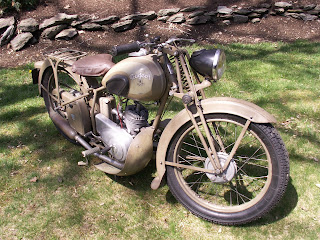I had a chance meeting with the Chief Judge of the Pebble Beach Concours d'Elegance last fall while in San Diego, California. Despite being one of the most respected members of the automobile community, Mr. Ed Gilbertson is also a longtime motorcyclist. He mentioned that they would be celebrating French motorcycles in 2013 at Pebble Beach and asked if I knew of any that should be considered for the event. I had recently purchased a 1949 Peugeot model 156 that was unrestored that had been in longterm storage. Given that I had a just 9 months to get the bike ready, should it be accepted, the clock was ticking on just what to do with the bike. Should we leave it "as is" or restore the machine?
Despite the complete but worn condition, we chose to do a super detail but leave the bike unrestored. I was influence by my exposure to the collection of Dr. Fred Simeone and Dick Miles, both of whom espouse the philosophy of Preservation over Restoration.
The two stroke 150cc Peugeot was introduced in 1949. It survived until 1958 with the later addition of telescopic forks and rear suspension.
This Motobecane was purchased in the immediate postwar period by the same family that still owns it today. It's a 125cc four stroke, with three speed hand shift Motobecane D45.
Both machines show the wear and tear associated with use after nearly 70 years. Both survived though, with original paint and in running condition. Both are headed to Pebble Beach Concours d'Elegance in August 2013 to celebrate French Motorcycles. They also represent a emerging trend of preservation rather than restoration. It will be interesting to see the publics reaction to this and whether auto and cycle collectors will have sufficiently restrained egos to not destroy an original finish in favor of shiny new paintwork.
























































